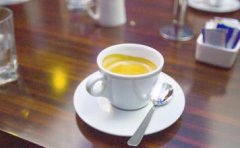A brief introduction to the origin, development, history and culture of Yunnan small-grain coffee Huaguoshan boutique coffee beans

Due to the excellent quality of Yunnan coffee, it entered the London market with "Lujiang No.1" in the 1960s and was rated as first-class. In recent years, the world-famous coffee companies such as Nestle and McDonnell have come to Yunnan to open up raw material bases, and the products produced in Yunnan are also gradually famous at home and abroad. At present, the average yield of coffee in Yunnan has reached 96.4 kg, and a household contracted land in Lujiang has set a world record of 400 kg. After visiting the coffee garden of Lujiang Farm, Steyhead, a chief coffee expert of the United Nations Planning and Development Program, said: "I have seen countless coffee plantations in the world. The management here is world-class and the yield per unit area is the highest.
Cardamo Catimor is an improved variety of Tiebika seed, with 25% Robusta gene Yunnan small-grain coffee with good quality. Take Lujiangba small-grain coffee as an example: the percentage contents of the main components are as follows: crude fat 17.1, reducing sugar 0.93,starch 3.07,nitrogen 2.27,crude protein 1.419, ash 3.70,19.33 crude fiber, 2.14,9.20 sucrose and 6.87 moisture. Yunnan Little Coffee really doesn't impress me very well. The simple taste of the entrance is good, not bitter, not sour enough. The most disappointing thing is that Yunnan small-grain coffee does not have enough aroma and not much oil. After getting it out with a high-pressure machine, there is less coffee oil and coffee brewing.
Pu'er, Xishuangbanna, Wenshan, Baoshan, Dehong, Lincang and other places in the south and west of Yunnan are all the distribution areas of small-grain coffee in Yunnan. As of January 1, 2012, according to the comprehensive survey of Yunnan Province, the planting area of coffee in Yunnan has exceeded 800000 mu, and the output of coffee beans in this period is expected to exceed 55000 tons. For the future, local governments in Yunnan have also drawn a blueprint: Dehong is planning to expand the coffee planting area from the current 100000 mu to 200000 mu in the next few years; Lincang plans to expand the existing 20, 000-mu coffee forest by 10 times to 200000 mu in the 12th five-year Plan; and Pu'er also plans to expand the 220000 mu coffee forest to 600000 mu. Other areas suitable for coffee cultivation, such as Baoshan and Xishuangbanna, are also planning to expand the planting scale. Yunnan Coffee Network is the only professional coffee website that comprehensively introduces the information and culture of coffee in Yunnan and the cultivation, production, processing, consumption and other links of the coffee production chain. the weekly coffee quotation offered by this website is currently the price of coffee raw beans with the longest duration and the most reference transactions in China.
According to reports, in 1892, French missionary Father Tian used coffee fruit to breed the first coffee tree outside the church, and then cultivated more coffee trees and planted them around the church. Since then, the village of Zhukula began to grow coffee, and the village has been surrounded by coffee trees ever since. Qi Guanghui and Li Fusheng, the two oldest elders in the village, are both in their eighties this year, and together they have witnessed the formation of the oldest coffee forest in China.
Although Zhu Kula is poor and backward, it has an inextricable bond with coffee. In addition to growing coffee all over the country, the villagers all have a tradition of drinking coffee: self-growing, self-grinding and self-brewing, and now men, women and children in the village have the habit of drinking coffee. The villagers here have a special feeling for the coffee tree, even if the coffee beans do not bring them any economic benefits, the villagers are not willing to cut down a coffee tree.
Zhukula Village receives guests with local coffee and walnuts, although the coffee made from earthen cans is not the best, but this primitive drinking method reflects the love of coffee among Zhukula villagers and is the highest etiquette reception for guests. The unique and rich original coffee culture makes everyone who knows Zhu Kula have to sigh that it is worthy of the first coffee village in China.
Yunnan coffee is mostly planted in dry and hot valleys at an altitude of 1100 meters above sea level, so it has a moderate sour taste, rich and mellow aroma. In terms of climatic conditions, the long light time in southern Yunnan is conducive to plant growth and photosynthesis, and the large temperature difference between day and night and low temperature at night are conducive to the accumulation of coffee nutrients. Therefore, the effective nutrients of Yunnan small-grain coffee are higher than those of other foreign coffee varieties. Small seed coffee is easy to be infected with rust, and the yield and quality of embroidery disease are deeply affected. In the hot area of Yunnan, due to the distinct dry and wet, the red ripening of fresh fruit enters the dry season every year, and the relative humidity is low, which is not conducive to the formation and growth of rust blister.
Zhukula coffee forest belongs to Arabica bean (Arabica) Yunnan small grain Bobang (bourbon) and Tiebika (Typica) varieties.
By 2014, the coffee planting area of Yunnan Province is 1.83 million mu, and it is estimated that the coffee planting area of Yunnan Province will reach 2.8 million mu by 2020.
Main producing area
Small-grain coffee is suitable for growing in the mountain area of 800 meters above sea level. If the altitude is too high, it will taste sour, and if it is too low, it will taste bitter. Small grains of coffee are mostly planted in dry and hot valleys about 1100 meters above sea level, so they are moderately sour, rich and mellow. There is a unique environment suitable for the growth of small seed coffee in many areas of Yunnan, and the quality of small seed coffee is excellent.
The planting areas are mainly distributed in Lincang, Baoshan, Simao, Xishuangbanna, Dehong, Nujiang and other states.
The average temperature of Lujiangba in Baoshan is 21.5℃, and the highest is 40.4 ℃, which is basically frost-free all the year round. It is recognized as the best producing area of small-grain coffee. The small-grain coffee cultivated here is famous at home and abroad for its strong but not bitter, fragrant but not strong, well-proportioned small noodles, mellow and fruity.
In recent years, the planting area of small-grain coffee in other producing areas of Yunnan has been expanding, the quality has also made great progress, and the popularity of small-grain coffee has been improved both at home and abroad.
After inspecting the coffee planting and primary processing base in Yunnan, the tasting experts of the International Coffee Organization rated Yunnan coffee as the kind of small seed coffee processed by Colombian wet processing, which is the highest quality coffee in the world.
Although the environmental problems of coffee cultivation can reach the standard of hot areas, they are far away from the equator, evaporation, large-scale coffee cultivation in Yunnan is less than 1100m above sea level, the severe drought in Yunnan in recent years, and the frost period in the producing areas, and so on, all make coffee planting can not be guaranteed normally, which directly affects the quality of coffee production. As for other processing problems, not to mention the quality of farmers, tea farmers have been drinking tea for generations, but farmers may not have had coffee in their lives.
Say so much, but it doesn't mean that you haven't had a cup of good Yunnan coffee, and if the post-processing and roasting is good, as a friend here said, the coffee from several hills, such as Pu'erman Laojiang, Kaddura of Manzhong Tian, Tielinka of Baihualing of Lujiang, Baoshan, and Bourbon of Lujiang, Baoshan, are good, especially resistant. Typica and Bourbon, two classic high-quality coffee varieties with an altitude of 1800m, are the main coffee varieties in Yunnan. In 1991, Katimo Catimor series varieties were introduced from Kenya (with stronger anti-virus ability and higher yield). A variety of Arabian species (also known as small seed species). Because the morphology and habits of the two varieties are similar, the two varieties are mostly mixed.
Tibica coffee, native to Ethiopia and southeastern Sudan, is the most widely cultivated variety of coffee in the Western Hemisphere. The plant is stronger, but not light-tolerant, and the yield is higher in Hawaii. The top leaf of Tibika is red and copper, which is called red top coffee.
Bourbon coffee is a variety of small-grain coffee second only to Tibica. At first, the main branch and the trunk grew upward at 45 degrees, and drooped with fruit load, the lateral branches were denser, the fruit was more, and the yield was higher. But the berries are smaller and ripen more slowly. The top bud of Bobang is green, which is called green top coffee.
So on the whole, I think Yunnan small grains can be filtered with American-style drip, and the high-pressure machine will not be more fragrant. It is more suitable for instant materials. If you really want to use small grains as a base, then you must buy newly baked beans (you can choose that kind of advance payment on Taobao, wait for the next batch of baked directly packaged and sent out, buy 500g), now grind it out, it will be a little more fragrant
Yunnan coffee is a variant of Arabian original species, which has been cultivated for more than one hundred years after long-term cultivation and domestication. Due to the unique geographical environment and climatic conditions, Yunnan coffee has formed a unique flavor of strong but not bitter, fragrant but not strong, with a little fruit flavor. World-class coffee experts evaluate it as the best coffee in the world, and its cultivation techniques. The yield per unit area is also world-class. The quality of coffee depends on many factors, such as growing environment, climate, cultivation and management techniques and so on. Its best growing environment is low latitude, high altitude, sufficient rainfall and suitable sunshine, so the north latitude is 15. The ideal growing area for coffee is between the Tropic of Cancer and the Tropic of Cancer. However, other areas in this zone, such as Hawaii and Saudi Arabia in the United States, or low altitude or little rain in the desert, are not conducive to coffee growth, only southern Yunnan in this zone happens to have all kinds of conditions. According to the determination of experts, small-grain coffee should be planted in the mountains of 800m above sea level. If the altitude is too high, it will taste sour, and if it is too low, it will taste bitter. The planted land needs a certain slope, otherwise the quality of the coffee is slightly worse, and there are many diseases.
Berries broadly elliptic, red, 12-16 mm long, 10-12 mm in diameter, exocarp dura, mesocarp fleshy, sweet at maturity; seeds raised abaxially, ventral flat, longitudinally grooved, 8-10 mm long and 5-7 mm in diam. Florescence from March to April
Cutting materials with straight branches, can not use a branch, because a branch cuttings after the new plant can only grow creeping, can not grow into a straight coffee tree. Cuttings should be cut with green uncorked, fully aged leaves, robust straight terminal buds at the bottom of paragraphs 2-3, not semi-corked and corked straight branches. The leaves of cuttings are four inches wide (about 6-8 cm), and each section of cuttings is 4-6 cm long. The cuttings are cut into two pieces, each with a blade, and the cut is oblique and smooth.
The slotting machine generally uses a sand bed with a thickness of 40-50 cm, with coarse sand in the lower part and medium fine sand in the upper part. The shade degree of the slotting bed should be 80-90%. Wash the sand first when using it, or you can mix it with the coconut bran of 1 stroke 2. Using spray equipment, the rooting rate of cuttings is high, but the cost of equipment purchase is high.
The cuttings can be cut obliquely or directly, and the cutting depth is buried at the leaf node. 10-15 cm in a row, with the leaves not covering each other as the standard. Fully sprinkle with water after insertion to make the cuttings in close contact with the sand. After cutting, plastic film should be covered on the cutting bed to reduce water evaporation and improve the rooting rate of cuttings. When covering the plastic film, it should be arched with iron wire or bamboo, inserted on the edge of the sand bed, and then covered with the plastic film, and then pressed to maintain the humidity in the bed. If you use spray equipment, you don't have to cover plastic film.
Important Notice :
前街咖啡 FrontStreet Coffee has moved to new addredd:
FrontStreet Coffee Address: 315,Donghua East Road,GuangZhou
Tel:020 38364473
- Prev

Rich aroma of Yunnan small Coffee Huaguoshan boutique Coffee Bean Flavor and aroma description Jane
Cardamo Catimor is an improved variety of Tiebika seed, with 25% Robusta gene Yunnan small-grain coffee with good quality. Take Lujiangba small-grain coffee as an example: the percentage contents of the main components are as follows: crude fat 17.1, reducing sugar 0.93,starch 3.07,nitrogen 2.27,crude protein 1.419, ash 3.70,19.33 crude fiber, 2.14,9.20 sucrose and 6.87 moisture. Cloud
- Next

A brief introduction to the planting market price of Yunnan small-grain coffee Huaguoshan boutique coffee bean varieties with moderate sour taste
Yunnan coffee is a variant of Arabian original species, which has been cultivated for more than one hundred years after long-term cultivation and domestication. Due to the unique geographical environment and climatic conditions, Yunnan coffee has formed a unique flavor of strong but not bitter, fragrant but not strong, with a little fruit flavor. World-class coffee experts evaluate it as the best coffee in the world, and its cultivation
Related
- Detailed explanation of Jadeite planting Land in Panamanian Jadeite Manor introduction to the grading system of Jadeite competitive bidding, Red bid, Green bid and Rose Summer
- Story of Coffee planting in Brenka region of Costa Rica Stonehenge Manor anaerobic heavy honey treatment of flavor mouth
- What's on the barrel of Blue Mountain Coffee beans?
- Can American coffee also pull flowers? How to use hot American style to pull out a good-looking pattern?
- Can you make a cold extract with coffee beans? What is the right proportion for cold-extracted coffee formula?
- Indonesian PWN Gold Mandrine Coffee Origin Features Flavor How to Chong? Mandolin coffee is American.
- A brief introduction to the flavor characteristics of Brazilian yellow bourbon coffee beans
- What is the effect of different water quality on the flavor of cold-extracted coffee? What kind of water is best for brewing coffee?
- Why do you think of Rose Summer whenever you mention Panamanian coffee?
- Introduction to the characteristics of authentic blue mountain coffee bean producing areas? What is the CIB Coffee Authority in Jamaica?

